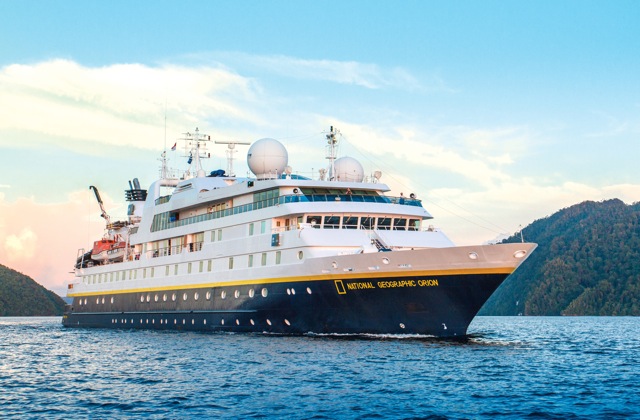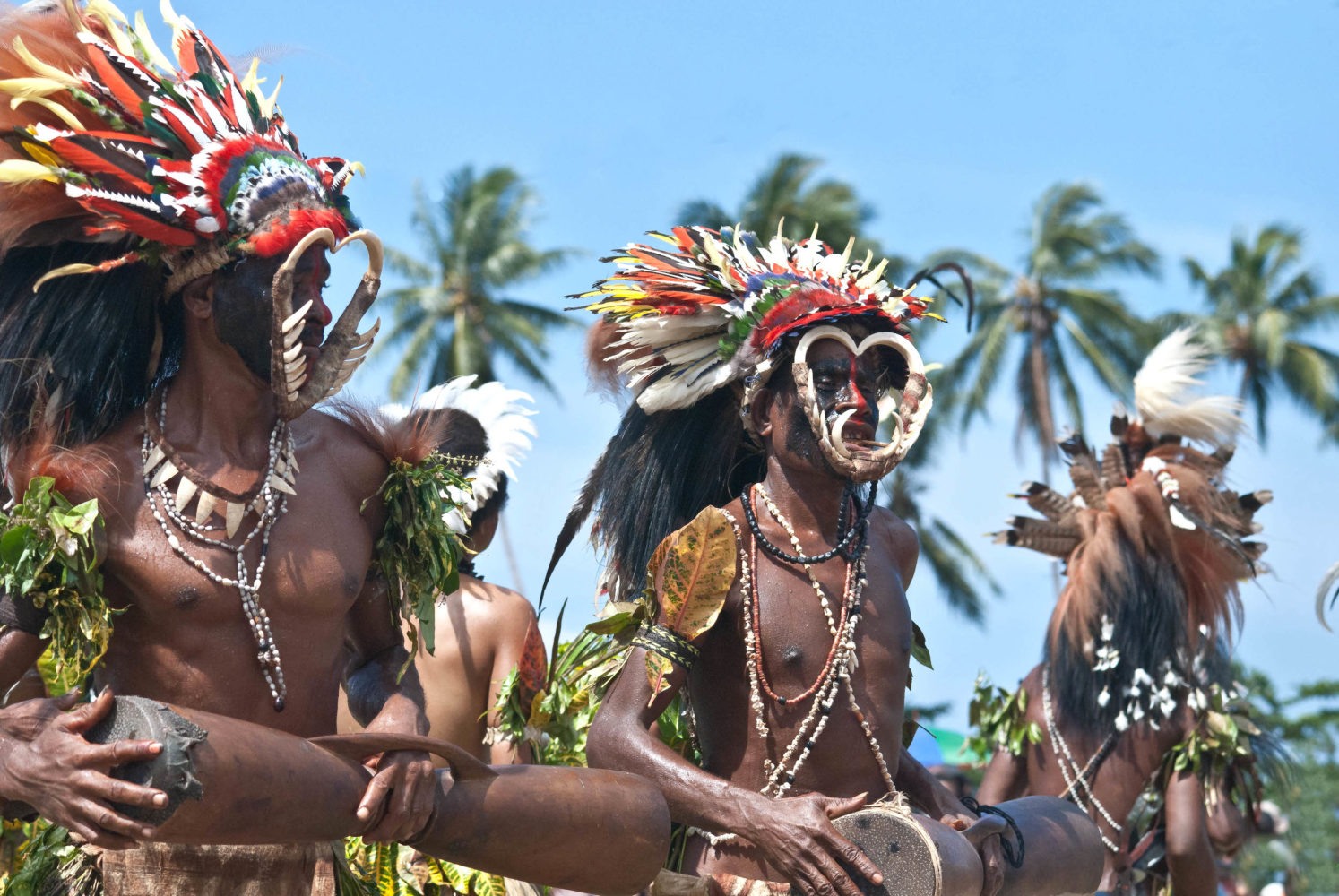The Pacific’s Last Frontier: Papua New Guinea
With a cheer from the crowd surrounding a hut nearly buried in palm fronds — a precaution against the prying eyes of the village’s women — the dragon charges drunkenly into the sunlight and humidity. Its face is the blood red of the betel nut chewers’ teeth, its beard a flow of white cockatoo feathers, and its body a long, winding chain of feet that weave behind, stumbling blindly through the Papuan Sepik River mud.
As it passes through thigh-high reeds and winds its way between towering coconut palms, villagers take turns to whip at the dragon’s brown feet, while children watch on from the shade of stilted huts, saucer eyed. We din dins, or white people, follow at a discrete distance, as respectful as we are wary of the beast’s precarious behind. At the centre of the village the dragon comes to a halt, and we are officially welcome.
Papua New Guinea is a funny place. Wild and remote, it’s not everyone’s idea of a tropical holiday destination. Its infrastructure is limited, its villages scattered up rivers, perched on mountaintops, or hidden away on pearl-like islands wreathed by coral gardens. Languages, traditions, and mythologies change frequently as one traverses the ruggedly beautiful coastline or delves into the deep jungle of the highlands. Little has changed since the first missionaries arrived to find wild landscapes and a biodiversity like nowhere else. It was, and remains, one of the world’s last frontiers.

However, one expeditionary cruise ship is working hard to open the country to tourists, funnelling much-needed hard currency into the islands while changing perceptions of this ‘wild west’ of the Pacific. Lindblad Expeditions’ National Geographic Orion offers unique cruising itineraries to some of the Pacific’s furthest flung corners, including the Kimberleys of Western Australia, East Timor, eastern Russia, Antarctica, and Papua New Guinea’s stunning southeast. They specialise in a type of cruising that’s equal parts soft adventure and comfort, with an emphasis on authentic encounters with people, wildlife and culture rarely witnessed by outsiders.
Papua had always been on my personal bucket list, as well as that of my brother Daniel. Growing up, we had heard all the myths and legends about these distant Pacific islands and jumped at the opportunity to explore this wild landscape by sea rather than tackling the limited network of often treacherous inland roads.
The National Geographic Orion is the perfect non-cruiser’s cruise ship. Unique in expeditionary circles because of its levels of luxury, she is intimate yet beautifully-appointed. Catering to only 102 passengers — more than most adventure ships, but a fraction compared to mainstream cruisers — she combines the elegance of a private yacht with the durability of a working vessel, complete with ice-strengthened hull. Guests can lounge in their spacious staterooms — ‘Owner’s Suites’ come with living spaces and Juliette balconies, perfect for early morning port arrivals — sample fine dining degustation menus and enjoy al fresco barbecues under the stars. They can even while away their downtime in an outdoor jacuzzi.

However, when the ship comes to port, it’s all action. Each day on National Geographic Orion features activities and excursions, with a fleet of powerful French military-grade zodiacs craned from the top deck and expeditions launched from the transom. ‘Wet’ beach landings, river cruises and village visits are interspersed with lectures and presentations during cocktail hour by a knowledgeable expeditionary team made up of biologists, photographers and adventurous spirits.
Our first taste of life in Papua New Guinea on our 11-day cultural odyssey — extending from Cairns in Australia to Rabaul on the volcanically-active island of New Britain — is Alotau in Milne Bay, one of the few towns along the southeastern coast of the country. Despite its dusty roads and dilapidated markets, it remains a major hub for the hundreds of villages scattered throughout the bay and the off-shore islands. Milne Bay also saw extensive fighting between Allied and Japanese forces in the Second World War, including a decisive victory by Australian soldiers over attacking Japanese marines, just outside the town. A memorial for the Allied soldiers who lost their lives remains a telling reminder on the town’s now serene foreshore.
I follow the ship’s expeditionary team leader into Alotau on one of his fascinating guided walks. A bellowing, towering man with a keen eye and a seemingly limitless knowledge of Papua, Justin Friend spent many years living in the Highlands. He was married to a Papua New Guinean woman, and speaks fluent Pigeon, the sing-song, phonetic-inspired dialect of the islands. His love for Papua and its people is contagious — he can barely leave the port without people yelling out his name with a wave and a smile.
Alotau is best known for its lively markets, where villagers from the province gather to sell produce, carvings and the most prized commodity of all, betel nuts, which are chewed by virtually everyone in Papua New Guinea. This results in plenty of teeth and gums stained a bloody red hue. The bright white eyes, dark cocoa skin and facial tattoos of the stallholders captivate the camera lenses of the Orion passengers and offer a tantalizing first taste of this mesmerising country.

Orion’s cruises are all about these cultural meetings, with opportunities to engage real people, in their ancestral villages, without a tour guide flag or staged photo opportunity in sight. Exploring Samarai Island the next day — once the pearl of Milne Bay and a popular settlement for expatriates living in Papua New Guinea — Dan and I follow the sound of laughter and find a gang of gleaming children diving off a jetty. Escaping the oppressive tropical heat, Dan and I strip down and jump into the brilliantly clear water to a roar of laughter from the kids and their parents resting in the shade of the nearby markets.
Kitava, in the Trobriand chain, is an idyllic archipelago of coral atolls that was once known by shocked missionaries as the Love Islands because of its unique matrilineal society. Here, we watch school children perform both ancient tribal dances and contemporary interpretations, their feet kicking up the sand as they writhe and wriggle. The faces of these pint-sized warriors are blackened with charcoal, while brilliantly-coloured parrot feathers dance from their necks as well as from the tips of their crude spears. Their school chums lie in the sand and giggle, their feet swaying in the air in time with the drums.
Our island exploration continues as we arrive amid the sun-lit peaks of Tufi, on the cusp of Cape Nelson. One of Papua New Guinea’s best kept secrets, Cape Nelson was created by the eruption of three towering volcanoes, whose swift lava flows created a series of unique fjord-like formations called rias, that boast depths of up to 90 metres, with sheer cliffs climbing 150 metres either side. At the head of these rias, mangrove forests act as fish hatcheries, while the entrances are protected by brilliant coral reefs.
As guests depart for a snorkel at the outer reef, a village tour, or a hike through lush vegetation and paddocks of tropical flowers of Suicide Point, Dan and I make for the beach, a sliver of paradise fronted by a sun-kissed turquoise lagoon and backed by rolling hills in blazing green hues. Hearing drums beating in the hills, we go to investigate and are welcomed into a tiny village overlooking a particularly deep ria. Elders have gathered to welcome officials from the capital, Port Moresby, with a traditional ‘sing-sing’, a series of dances and songs which tell the history of the village. Four generations of one family perform the timeless dance steps, their elaborate headgear ablaze with the feathers of cockatoos, lorikeets and birds of paradise.

Up the coast, we travel by traditional canoes along a shallow river that winds its way through dense jungle. A father and son crew our simple outrigger, dipping their oars into the water with little, well-practiced flicks of the wrists. Both are dressed in traditional loin cloths and bright feathers which encase their biceps and burst into colour as the sunlight punctures the canopy above. The silence of the jungle is deafening, until suddenly tribesmen carrying spears attack from both sides in a simulated ambush that has me nearly clambering out of the raft and into the murky water. The young boy at the bow quietly suppresses a laugh as I rearrange myself on the rather precarious raft with a new found respect for the early explorers who delved deep into the Papuan jungle, many never to return.
Our cruise nearly over, and with our final destination — the volcanic mountain of Rabaul — only a night’s sail away, Dan and I board a dive boat bound for the seas outside the eastern town of Madang. Here, we plan to investigate a local legend. An American B-25 bomber was shot down by the Japanese some 70 years before, crash landing in the sea and settling 30 metres below the waves. For my brother and I, exploring this hidden piece of history is a truly unique, and humbling, experience.
The warm tropical seas of Papua New Guinea have been surprisingly merciful: an inquisitive moray eel now calls the starboard wing home, and delicate lionfish frolic in the bullet hole-ridden fuselage, but the ancient bomber is still in remarkable shape. We dive deep, ducking below gun turrets and taking turns to sit in the cockpit, streams of bubbles dancing up to the surface above. The experience is exhilarating, but it also makes the history of Papua New Guinea and Madang that much more tangible and real.
I’m sad to be leaving Papua the next day as our charter jet soars into the sky, bound for Australia. The past 11 days have been a kaleidoscope of colours, cultures, scenery and encounters that won’t soon be forgot, but I’m comforted, looking down to the endless jungle, the towering peaks and winding rivers below, that there is still plenty of Papua’s wild side yet to be discovered.

